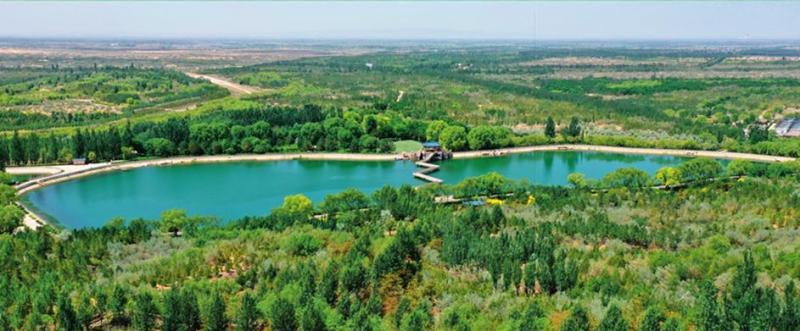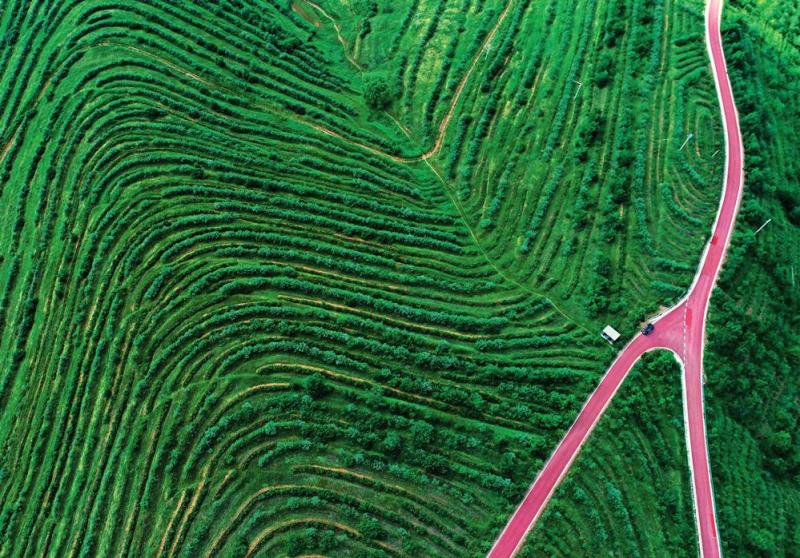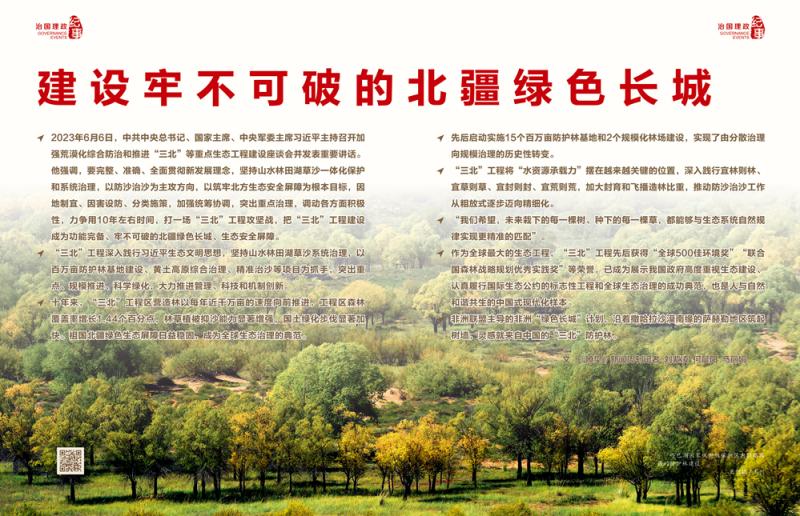Outlook · Chronicles of Governance | Building an Unbreakable Green Great Wall in Northern Xinjiang | Ecology | Construction
He emphasized the need to fully, accurately, and comprehensively implement the new development concept, adhere to the integrated protection and systematic governance of mountains, rivers, forests, fields, lakes, grasslands, and sands, take sand prevention and control as the main direction of attack, and build a strong ecological security barrier in the north as the fundamental goal. Tailor measures should be taken according to local conditions and hazards, and classified policies should be implemented. Strengthen overall planning and coordination, highlight key governance, mobilize the enthusiasm of all parties, and strive to fight a battle against the "Three North" project in about 10 years, and build the "Three North" project into a fully functional and unbreakable green Great Wall and ecological security barrier in northern Xinjiang.
The "three North" project deeply implements Xi Jinping's thought of ecological civilization, adheres to the systematic management of mountains, rivers, forests, fields, lakes, grass and sand, and starts with the construction of a million mu shelterbelt base, the comprehensive management of the Loess Plateau, and accurate sand control. highlight key points, scale promotion, scientific greening, and vigorously promote management, science and technology and mechanism innovation.
Over the past decade, the afforestation in the "Three North" project area has been advancing at a rate of nearly ten million mu per year. The forest coverage in the project area has increased by 1.44 percentage points, and the ability of forest and grass vegetation to suppress sand has been significantly enhanced. The pace of national greening has significantly accelerated. The green ecological barrier in northern Xinjiang of our country is becoming increasingly stable and has become a model of global ecological governance.
We have successively launched and implemented the construction of 15 million mu protective forest bases and 2 large-scale forest farms, achieving a historic transformation from decentralized governance to large-scale governance.
The "Three North" project has placed "water resource carrying capacity" in an increasingly critical position, deeply practicing the principles of "suitable for forest, suitable for grass, suitable for sealing, and suitable for wasteland", increasing the proportion of closed cultivation and aerial seeding afforestation, and promoting the gradual refinement of sand prevention and control work from extensive to refined.
We hope that every tree planted and every grass planted in the future can achieve a more precise match with the natural laws of the ecosystem.
◇ As the largest ecological project in the world, the "Three North" project has successively won the "Global 500 Best Environment Award", "United Nations Strategic Forest Planning Excellence Practice Award" and other honors, which has become a landmark project to show that the Chinese government attaches great importance to ecological construction, earnestly implements international ecological conventions, and a successful example of global ecological governance. It is also a model of Chinese path to modernization in which people and nature coexist in harmony.
◇ The "Green Great Wall" plan in Africa led by the African Union built a tree wall along the Sahel region on the southern edge of the Sahara Desert, inspired by China's "Three North" shelter forest.
Wen | "Liaowang" Newsweek reporter Liu Ziling He Chenyang Ma Lijuan
In the prime of summer, the northern region of our motherland is covered in green.
From a high altitude, on the ten thousand mile sandstorm belt that stretches from Xinjiang in the west to Heilongjiang in the east, yellow and green alternate. In 45 years, the world's largest ecological project, the "Three North" Shelterbelt Project, has created a "green miracle" across more than 4 million square kilometers of land in northern China. Hundreds of millions of people have planted new green patches and built a green Great Wall that stretches for thousands of miles, achieving a historic transformation from "sand in and people out" to "green in and sand out".
China is one of the countries with the most severe desertification in the world. The Northwest, North China, and Northeast regions, known as the "Three North", are home to China's eight major deserts, four major deserts, and vast deserts. The desertified land accounts for about 90% of the country's desertified land area, making it the core area for desertification prevention and control in China.
In 1978, the Central Committee of the Communist Party of China, starting from the perspective of sustainable development of the Chinese nation, drew up a grand project that spanned a century. The project was planned to take 73 years and be divided into three stages and eight phases. A large protective forest system was built in the "Three North" areas, with a planned afforestation of 35.08 million hectares.
Since the 18th National Congress of the Communist Party of China, General Secretary Xi Jinping has repeatedly given important instructions to continue to promote the construction of the "Three Norths" project.
He emphasized the need to fully, accurately, and comprehensively implement the new development concept, adhere to the integrated protection and systematic governance of mountains, rivers, forests, fields, lakes, grasslands, and sands, take sand prevention and control as the main direction of attack, and build a strong ecological security barrier in the north as the fundamental goal. Tailor measures should be taken according to local conditions and hazards, and classified policies should be implemented. Strengthen overall planning and coordination, highlight key governance, mobilize the enthusiasm of all parties, and strive to fight a battle against the "Three North" project in about 10 years, and build the "Three North" project into a fully functional and unbreakable green Great Wall and ecological security barrier in northern Xinjiang.
In 2012, the National Development and Reform Commission approved the Five phase Plan for the Construction of the "Three North" Shelterbelt System. In 2022, the National Forestry and Grassland Administration issued the Implementation Opinions on Comprehensively Promoting the Scientific Greening of the Three North Project, making policy and institutional arrangements for the in-depth development of the Three North Project construction.
The Three North Bureau of the National Forestry and Grassland Administration has successively issued the "Interim Measures for the Management of Forestry Demonstration Construction Projects for Comprehensive Governance of the Loess Plateau in the Three North Project" and the "Pilot Management Measures for the Transformation of Degraded Forests in the Three North Project" in combination with new situations and tasks, providing theoretical and practical basis and technical support for scientific promotion of engineering construction.
The ten years since the 18th National Congress of the Communist Party of China have been the construction period of the fifth phase of the "Three North" project.
Grass and trees reshape mountains and rivers with the power of flexibility. Over the past decade, the afforestation in the "Three North" project area has been advancing at a rate of nearly ten million mu per year. The forest coverage in the project area has increased by 1.44 percentage points, and the ability of forest and grass vegetation to suppress sand has been significantly enhanced. The pace of national greening has significantly accelerated. The green ecological barrier in northern Xinjiang of our country is becoming increasingly stable and has become a model of global ecological governance.

Baijitan National Nature Reserve in Lingwu City, Ningxia
System governance: coordinating mountains, rivers, forests, fields, lakes, grasslands, and sands
In recent years, good news of the return of wild animals has been frequently heard in the "Three North" areas - the ecological indicator species Leopard Cat has appeared on the Baiji Beach in Lingwu City, Ningxia. Groups of wild camels have frequently appeared on the banks of the Shule River in Dunhuang, Gansu Province, which is known as the "Chinese drought pole". State key protected wild animals such as the spotted autumn sand duck have repeatedly visited Wuliangsuhai in Inner Mongolia
These places used to be barren mountains and barren hills, with yellow sand flowing everywhere. After continuous and unremitting ecological protection and restoration, they are now lush with forests, grass, and vitality. The restoration of biodiversity indicates that ecosystems are becoming increasingly healthy and stable.
Since the 18th National Congress of the Communist Party of China, the "Three North" project has adhered to the concept that mountains, waters, forests, fields, lakes, grasses, and sands are a community of life. It takes the restoration and expansion of forest vegetation in mountain basins as the basic framework, and focuses on key areas of soil erosion and sandstorm hazards as the main targets, promoting the overall construction of the project.
Reasonable zoning and the construction of a large-scale cross regional protective forest system. Spread out the map of the "Three Norths" and five phases of the project. From west to east, different colors show the northwest desert area, loess plateau hilly and gully area, wind and sand area, and northeast North China Plain agricultural area.
The overall planning of the fifth phase project takes into account the continuity of geographical units, the rational layout of terrain and climate characteristics, and is divided into four major construction areas. Based on a detailed investigation of the natural ecological conditions of water, soil, gas, and vegetation in each zone, precise identification of the main ecological problems, and efforts to protect existing vegetation, the project has proposed the main focus of protection and restoration in each zone.
In the northwest desert, a protective forest system dominated by sandy shrubs protects the oasis; In the Loess Plateau, the ecological and economic protective forest system covers the barren mountains; In windy and sandy areas, a windbreak and sand fixation forest system combining trees, shrubs, and grass locks in yellow sand; In the Northeast North China Plain, the efficient farmland shelterbelt system protects the "big granary".
Over the past decade, the construction of these large-scale cross regional and cross basin protective forest systems has played an important role in building a complete regional ecological barrier and enhancing the stability of the ecosystem.
Systematic governance, with the watershed and mountain system as the basic unit for comprehensive management. In different zones, each region adapts to local conditions, considers the coordination of various elements, and combines biological and engineering measures to gradually build a comprehensive protective forest system that combines agriculture, forestry, animal husbandry, soil and water forests, multiple forest species, multiple tree species, strip nets, trees, shrubs, and grasses, and multiple benefits.
The Loess Plateau, adjacent to the sandstorm area, has severe soil erosion and a large area of desertified land, making it a key area for the construction of the "Three North" project. In 2013, the "Three North" project launched a forestry demonstration construction project for comprehensive management of the Loess Plateau in 40 counties, implementing comprehensive management of mountains, water, forests, fields, and roads, and promoting overall development according to river basins and mountain systems.
Pengyang County in Guyuan City, Ningxia, located in the core area of the Loess Plateau, was once one of the counties with the most severe soil erosion in China. Once a rainstorm formed a roaring flood, scouring the soil fertility and carrying a large amount of sediment to the Yellow River. In recent years, Pengyang County has explored a three-dimensional management model of "wearing hats on the mountaintop forest and grass, wearing belts on the mountainside terraced fields, and wearing boots on the ditch and reservoir dams", promoting the entire mountain, ditch, and watershed.
After the implementation of the project, the speed of small watershed management in Pengyang County has accelerated. At present, the area of soil erosion in the entire county has decreased by over 80%. The scene of "the mountain is a monk's head, and the wind blows away the loess" is no longer reappeared. Yang Fengpeng, a senior forestry engineer of Pengyang County Natural Resources Bureau who has planted trees for more than 30 years, stood on the top of the mountain, looked at the forest terraces surrounded by the mountains and the densely covered fish scale pits, and said: "Now, even if we encounter the rainstorm once in 20 years, we are not afraid of it. We can stop the water, cure the soil, and keep the land."
In the past decade, from Liupan Mountain to Lvliang Mountain, from Guanzhong Basin to Fenhe Valley, the Loess Plateau has pressed the "fast forward" button, and the coverage of forest and grass vegetation has reached 59.06%, effectively blocking the spread of sand sources. Nowadays, 61% of the soil erosion area in the "Three North" project area has been effectively controlled, with an annual reduction of about 400 million tons of sediment entering the Yellow River.
Overall consideration, coordinate the development of forests and the prosperity of the people for a win-win situation. It is necessary to fully consider the impact of human factors on natural systems, transform people's unreasonable production and lifestyle, and prevent the expansion of desertification from the source, in order to carry out ecological governance with a systematic concept.
Since the 18th National Congress of the Communist Party of China, the construction of the "Three North" project has been closely integrated with poverty alleviation and rural revitalization strategies. Under the premise of ecological protection, we have vigorously developed characteristic forestry and fruit industry, sand industry, ecological tourism, etc., promoting the optimization of rural economic structure.
Relying on the "three north" project, Xinjiang has basically formed three distinctive forest and fruit production bases in southern Xinjiang, eastern Xinjiang and northern Xinjiang, with forest and fruit income in key areas accounting for more than 50% of farmers' net income; Alxa League in Inner Mongolia will combine afforestation and sand industry to develop 1.2337 million mu of Haloxylon ammodendron forests inoculated with Cistanche deserticola. The average annual planting income of herdsmen is 30000 to 50000 yuan, with some herdsmen earning 100000 yuan per year; While developing forestry characteristic industries in Qinghai, 49900 ecological management and protection personnel were selected and registered for impoverished populations, driving nearly 180000 impoverished people out of poverty in the province
According to incomplete statistics, about 15 million people in the "Three North" project area rely on characteristic forestry and fruit industry to achieve stable poverty alleviation. The expected contribution rate of the "Three North" project to the poverty alleviation and wealth creation of the people in the project area is 27%. The concept of "green mountains and clear waters are like mountains of gold and silver" is rooted in the "Three North" land, from deforestation and land reclamation to increasing greenery and generating gold, making the hard-earned green more stable and sustainable.
Highlighting key points: Driving the overall situation through points and surfaces

In Zhangwu County, Fuxin City, Liaoning Province, the sea of pinus sylvestris var. mongolica stands proudly on the southern edge of Horqin Sandy Land like rows of "green guards".
Zhangwu County is a sandstorm mouth in Liaoning Province, and the area of desertified land once accounted for 96% of the total area of the county. Yellow sand can sweep over the Liaohe Plain in just two hours. Nowadays, the forest belt formed by comprehensive management has greatly reduced wind and sand damage. Horqin Sandy Land is a key control area. The fifth phase of the "Three North" project has started the construction of three million mu windbreak and sand fixation forest bases and one key area around the Horqin Sandy Land.
From the satellite map, it can be clearly seen that from Chaoyang City and Fuxin City in Liaoning Province, Tongliao City in Inner Mongolia, Baicheng City and Songyuan City in Jilin Province, to Daqing City and Qiqihar City in Heilongjiang Province, a series of concentrated windbreak and sand fixation forest bases form a circular green barrier at the southern and eastern edges of Horqin Sandy Land, blocking several air outlets and forming an encirclement trend.
The governance approach that highlights key areas and drives the overall situation has effectively promoted the high-quality development of the "Three North" project.
——Key breakthroughs and scale development. The "Three North" project area spans half of China's rivers and mountains, and ecological governance is extremely difficult, so we cannot simply grasp the situation. The construction of the project has established the principles of "adapting measures to local conditions, setting up defenses based on hazards, prioritizing ease over difficulty, moving from near to far, highlighting key areas, and implementing large-scale governance", with a focus on breaking through and coordinating regional development, constructing regional ecological defense lines, and driving the overall improvement of the ecology in the "Three North" region.
At the same time, engineering keeps pace with the times, highlighting the main direction of engineering construction according to the key points of national economic and social development in different periods and stages, clarifying governance goals, priorities, and tasks, and promoting engineering construction in a planned, focused, and step-by-step manner.
The fifth phase of the "Three North" project has planned a number of regions with important ecological locations, identified 18 key construction areas, including four major sandy lands, including the Horqin Sandy Land, as well as Hetao Plain, Hexi Corridor, Tarim Basin, etc., and targeted the construction of farmland shelter forests, windbreak and sand fixation forests, water and soil conservation forests and water conservation forests.
——Concentrated investment, big projects drive big development. Nearly 60% of the investment tasks in the "Three North" Phase V project are focused on key projects. For example, 15 million acre protective forest bases and 2 large-scale forest farms have been launched and implemented successively, achieving a historic transformation from decentralized governance to large-scale governance.
Driven by key projects, various regions have adapted to local conditions and continuously promoted base construction at an average annual rate of 100000 to 200000 acres, with progress generally faster than general engineering construction areas.
The average vegetation coverage of Hulunbuir sandy land has reached 68.27%; Green barriers have been built along the 600km provincial boundary between Liaoning and Inner Mongolia, blocking the southward invasion of Horqin Sandy Land; The degree of agricultural forest networking in the western part of Heilongjiang Province has reached over 75%, and a regional protective forest system with agricultural protective forests as the main body has been basically established; Yulin City in Shaanxi Province has built a camphor pine forest sea with a total area of over 1.9 million acres in the Maowusu sandy land, forming a green corridor with highways as the axis and hundreds of kilometers long. The green ecological barrier in northern Shaanxi has begun to take shape.
"According to the evaluation results of the fifth phase of the 'Three North' project, the completed afforestation area of key projects accounts for 42.04% of the completed afforestation area, and the quality of afforestation is significantly better than that of general afforestation, which has a significant demonstration effect on promoting the high-quality development of the 'Three North' project." Zhang Liang, Deputy Director of the Three North Bureau of the National Forestry and Grassland Administration, introduced.
At present, the National Forestry and Grassland Administration is focusing on the three iconic battles of fighting the "several bends" of the Yellow River, annihilating the two major sandy areas of Horqin and Hunshandak, and obstructing the edge of the Hexi Corridor Taklamakan Desert. Efforts are being made to prepare for the sixth phase of the "Three North" project, develop a timetable and roadmap, decompose tasks, and refine measures.
Feng Degan, director of the Three North Bureau of the State Forestry and Grass Administration, said that the Three North Bureau will completely, accurately and comprehensively study and implement the spirit of General Secretary Xi Jinping's series of important speeches, and focus on the "Three North" project to fight tough battles, and specifically focus on systematic governance, three landmark battles, and scientific Sand control and other work to promote the high-quality development of the "Three North" project in the new era.
Photo by Wang Peng at Jinjiping Terraced Field Park, Pengyang County, Guyuan City, Ningxia/This magazine
Scientific desertification control: using water to determine green and sustainable development
In the scorching summer, nearly 700000 acres of flowing sand dunes in Baiji Beach, Lingwu City, Ningxia, located on the southwest edge of Maowusu Sandy Land, are locked in by a huge "green net". Workers carrying shovel and straw are "patching", and re dig straw squares in the area where the afforestation has not survived, waiting for a soaking rain, then they can seize the moisture and sow seeds. In the area that has been governed, patches of lime trees stretch their gray green branches, and the flower stick known as the "Desert Girl" blooms with purple red flowers.
Baiji Beach is extremely dry, with an annual rainfall of only about 160 millimeters. Wang Youde, a scientific sand control explorer, referred to the grass grid as the "main force" in sand control. "We have changed the passive sand control model of afforestation and relying on the sky for survival in the past season, and explored the use of grass grid sand fixation, three season afforestation, and focusing on rainy season afforestation. All rely on rain cultivation, and the survival rate can reach over 75% that year," he said.
"Planting a tree is harder than raising a child." This widely circulated saying in sandy areas reflects the most realistic dilemma of sand prevention and control. The majority of the "Three North" project area is located in arid and semi-arid areas with harsh natural conditions. The more arduous the task of afforestation and greening, the higher the demand for scientific greening.
Since the 18th National Congress of the Communist Party of China, with the increasing understanding of deserts and the continuous progress of scientific and technological means in China, the "Three North" project has placed "water resource carrying capacity" in an increasingly critical position, and has deeply practiced the practice of "suitable for forest, suitable for grass, suitable for sealing, and suitable for wasteland". The proportion of afforestation through sealing and aerial seeding has been increased, promoting the gradual refinement of sand prevention and control work from extensive to refined.

——Using water to determine greenery and precise sand control. In 2017, the former State Forestry Administration first proposed the concept of "precise desertification control" at the 6th Kubuqi International Desert Forum, with the core being to measure water, establish forests with water, and balance forest and water. In the same year, the "Three North" project launched 30 precision desertification control projects, accurately selecting vegetation restoration methods and afforestation densities based on the characteristics of desertification in different regions, the difficulty of control, and water resource endowments.
Minqin County, Wuwei City, Gansu Province, the "Sand Town of China", surrounded by Badain Jaran and Tengger Desert, is a national precision sand control county. On the basis of years of sand control, Minqin County is learning from nature how to control sand.
In the Xiaojingzi area of Xidahe, which is 20 kilometers away from the county town, there are grass grid shaped double eyebrow sand barriers, rice straw bundle upright sand barriers, nylon net sand barriers, etc., arranged in a staggered manner with multiple rows. After measuring the width and height of the sand barrier one by one, the researchers planted tree species such as Haloxylon ammodendron, Mao tiao, and sand jujube according to local water resources and other conditions.
This is the implementation site of the "Near Natural Biomimetic Principles" low coverage afforestation and five belts and one center technology research project in Minqin County. Xu Fangrong, a forestry engineer at Qinfeng Forestry Experimental Station in Minqin County, introduced that they conducted a comparative study of multiple sand barrier modes, planting different tree species at different row spacing. "Through experiments and observations, it has been found that the sand fixation forest in the low coverage row belt configuration mode is close to the local natural vegetation state and has significant growth advantages compared to the uniformly configured forest." Xu Fangrong said.
——Measure the amount of water and prioritize scientific research. With the deepening of engineering construction, the contradiction between forests and water in some areas has become increasingly prominent. The difficulty of afforestation in untreated areas is very high, and the "hard bones" that are difficult to gnaw on are concentrated in arid and semi-arid areas. It is urgent to more scientifically solve problems such as "where to build, what to build, and how to build".
In 2019, the National Forestry and Grassland Administration launched a research project on the water resource carrying capacity and optimal allocation of forest and grass resources in the "Three North" project construction. The project scanned the current situation and future trends of water resources in the "Three North" project area, analyzed the relationship between vegetation growth and ecological water demand, proposed a technical route mainly relying on natural precipitation, auxiliary artificial water replenishment, and the development of rain fed forest and grass vegetation, and proposed "water suitable" forest and grass vegetation construction technical solutions for different regions of the "Three North" project.
In 2022, the National Forestry and Grassland Administration issued the Implementation Opinions on Comprehensively Promoting the Scientific Greening of the Three North Project, proposing that by 2025, the scientific greening technology system of the Three North Project will be preliminarily established, and a number of scientific greening demonstration models will be built; By 2035, the scientific greening system of the "Three North" project will be further improved, and the modernization level of governance system and governance capacity will continue to improve.
The Three North Bureau of the National Forestry and Grassland Administration has identified 20 pilot counties for scientific greening in the "Three North" project, and has formulated the "Technical Guidelines for Scientific Greening in the Three North Project Counties", exploring new ways to coordinate ecological factors such as "water, soil and gas generation" and scientifically carry out greening in counties.
As one of the first pilot counties for scientific greening in the "Three North" project, Dengkou County, Bayannur City, Inner Mongolia, has conducted a thorough investigation of the suitable afforestation and greening spaces in the county, accurately dividing them into 2689 smallest units, totaling 830000 acres.
"We investigate the water, soil, air, and ecological conditions of each small class, develop a low-density afforestation management model, and maintain long-term stable vegetation growth," said Wang Zhiguo, director of the Dengkou County Desert Control Bureau. "We hope that in the future, every tree planted and every grass planted can achieve a more accurate match with the natural laws of the ecosystem.".
Anchoring a Global Model: Joining Hands to Build a Better Home
It is difficult for those who act alone to rise, but it is easy for many to follow.
In the face of global ecological and environmental challenges, humanity is a community with a shared future of prosperity and loss, and no country can stand alone. The extreme weather in 2023 once again reminds people that ecological and environmental issues have no borders and require close cooperation and joint construction of homes.
As the world's largest ecological project, the "Three North" project has successively won the "Global 500 Best Environment Award", "United Nations Strategic Forest Planning Excellence Practice Award" and other honors. It has become a landmark project to show that the Chinese government attaches great importance to ecological construction and earnestly implements international ecological conventions, and a successful example of global ecological governance. It is also a model of Chinese path to modernization in which people and nature coexist in harmony.
——Fulfilling green commitments and demonstrating "great country responsibility". The "Three North" project is the earliest project in China aimed at preventing and controlling desertification, effectively preventing the process of land desertification.
In 2015, the United Nations included desertification prevention and control in the 2030 Agenda for Sustainable Development, proposing the goal of achieving zero growth in global land degradation by 2030. Research from the Chinese Academy of Sciences shows that China has taken the lead in achieving this goal, and the "Three North" project has played an indispensable role.
In 2017, the 13th Conference of the Parties to the United Nations Convention to Combat Desertification was held in Inner Mongolia, the main battlefield of the Three North Project for desertification control. Ambassadors, government officials, experts and scholars from over 100 countries came to visit and inspect the effectiveness of the Kubuqi Desert governance. As a top student in sand prevention and control, China's miracle has attracted global attention and praise.
The "Three North" project is also a practical measure for China to actively participate in global climate governance and fulfill the Paris Agreement. In 2015, China submitted the "Strengthening Action on Climate Change - China's National Autonomy Contribution" to the Secretariat of the United Nations Framework Convention on Climate Change. China solemnly declares in this document that by 2030, the forest volume will increase by about 4.5 billion cubic meters compared to 2005.
Now, this goal has also been achieved ahead of schedule, and the "Three North" project has made important contributions to the continuous reconstruction of forests: over the past 40 years, the forest volume in the "Three North" region has increased from 613 million cubic meters to 3.042 billion cubic meters.

——Strengthen international cooperation and contribute "Chinese wisdom". On June 8 this year, the second technical training course on the construction of Africa's "Green Great Wall" was opened by the Xinjiang Institute of Ecology and Geography, Chinese Academy of Sciences. As part of this training course, the third Taklamakan Desert Forum was held in Korla, Xinjiang. Hundreds of researchers from countries and regions such as China and Africa gathered together to study how to effectively prevent land degradation and desertification in the Sahara and Taklamakan deserts.
Jia Xiaoxia, an official of the secretariat of the United Nations Convention to Combat Desertification, said that the African Union led "Green Great Wall" project built a tree wall along the Sahel region on the southern edge of the Sahara Desert, inspired by China's "Three North" shelter forest. "Some colleagues and project managers may ask how China's' Green Great Wall 'was built and whether the African region can also be successfully governed," said Jia Xiaoxia.
While providing economic support for the construction of the "Green Great Wall" in Africa, China has also dispatched scientific researchers for technical exchanges. At present, China has launched technical cooperation in big data application and planning with regions that are building the "Green Great Wall" in Africa. By using satellite and other means to observe, collect, calculate, and analyze data, it helps African countries understand their land, climate, and other characteristics and laws, and promotes local desertification control.
From the "Green Great Wall" of China to the "Green Great Wall" of Africa, the Chinese concept and plan for desertification control nurtured in the "Three North" region are promoting the global process of desertification prevention and control.
China supports the joint construction of desertification prevention and control in the "the Belt and Road" countries, leads countries to carry out policy dialogue and information sharing, jointly responds to the dust disaster weather, and continues to make positive contributions to global desertification control. In recent years, China has actively cooperated with the international community in desertification prevention and control by organizing international training, establishing demonstration bases for desertification control, and building exchange platforms. Every year, it has trained nearly 100 key desertification control personnel for developing countries in Asia, Africa, and Latin America.

Xinhua News Agency, Beijing, June 14th, title: To guide the right direction for the development of international human rights -- President Xi Jinping's congratulatory letter to the Global Human Rights Governance High-end Forum triggered a warm response Xinhua News Agency reporter "China is willing to work with the international community to implement the Vienna Declaration The spirit of the" Program of Action "promotes the development of global human rights governance in a more fair, just, reasonable and inclusive direction, and promotes the construction of a community with a shared future world." On June 14, President Xi Jinping sent a congratulatory letter to the high-end forum on global human rights governance, which triggered a warm response from Chinese and foreign guests. They said that President Xi Jinping's congratulatory letter put forward China's propositions on the development of the international human rights cause and global human rights governance, and clarified China's vivid practice of implementing the spirit of the Vienna Declaration and Program of Action and respecting and protecting human rights.

June 11th is China Population Day. Population development is a major event related to the great rejuvenation of the Chinese nation. The first meeting of the 20th Central Financial and Economic Commission recently stressed that Chinese path to modernization should be supported by high-quality population development. The meeting proposed to regard the construction of an education strong country as a strategic project for high-quality population development, comprehensively improving the scientific and cultural quality, health quality, and ideological and moral quality of the population. High quality scientific and cultural supply is continuously improving the scientific and cultural literacy of the people. The report of the 20th National Congress of the Communist Party of China clearly proposes to "strengthen youth sports work". Rock climbing, baseball, running, ice sports... Sports activities are gradually being added to students' schedules and becoming an essential part of their learning and life. The 14th Five Year Plan for Cultural Development points out that improving families and schools

Xinhua News Agency, Beijing, June 9th (Xinhua) -- The overall stability of domestic prices -- Interpretation of May CPI and PPI data. Xinhua News Agency reporters Wei Yukun and Han Jianuo released data on June 9th, showing that consumer demand continued to recover in May, with the national consumer price index rising by 0.2% year-on-year, an increase of 0.1 percentage points from the previous month; Excluding food and energy prices, the core CPI increased by 0.6% year-on-year, and the overall operation of domestic prices remained stable. In China's CPI basket of goods, food accounts for a relatively high proportion. In May, food prices increased by 1% year-on-year, an increase of 0.6 percentage points compared to the previous month. Among them, the prices of poultry, edible oil, and fresh fruits have increased by 5.6%, 3.6%, and 3.4% respectively, with all increases falling back; The price of pork has decreased from a 4% increase last month

Everyone said that on the new journey of comprehensively promoting the great rejuvenation of the Chinese nation, we should be firm in cultural self-confidence, take on the mission, and work hard to learn rich nutrition from the excellent traditional Chinese culture, refine and sublimate in the great practice of Chinese path to modernization, so that the Chinese civilization can glow with new vitality and vitality, and inject strong civilization nourishment and spiritual strength into the construction of a strong country and national rejuvenation. The cultural and national fortunes are intertwined, and the cultural context is connected to the national context.

The National Version Museum of China has undergone three years of construction and was completed on July 23, 2022